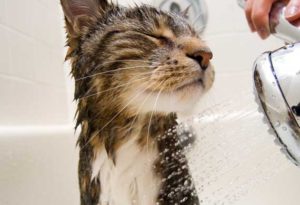By Dr. Beth Leermakers
Fleas can be the bane of a pet parent’s existence. In addition to irritating your pets, fleas can cause skin allergies and infections. They are the most common external parasites found on North American cats. Fleas can transmit bacterial infections, including cat scratch fever and the plague, to your cat and then to you.

Photos courtesy of Pet MD
To win the war against fleas, prevention needs to be a year-round battle.
Here are five strategies to keep fleas away from cats and dogs:
Flea shampoo. Bathing your pet in a medicated flea shampoo is an inexpensive way to prevent fleas. Many flea shampoos kill adult fleas and prevent them from returning. The best flea shampoos also prevent flea eggs and kill flea larvae from maturing into adults. You may need to bathe your dog every 1 – 2 weeks, since the active ingredients aren’t as long-lasting as the ones in topical or oral medications. In the dog rescue world, we foster parents swear by Dawn dishwashing soap to remove fleas from our new shelter dogs.
Unfortunately, cat flea shampoos only kill fleas on the cat when you bathe her, and they aren’t effective at killing the flea larvae coming from the environment post-treatment. If you’re up for bathing your cat regularly (sounds torturous to me!), be sure to choose a shampoo that is safe for cats.
Topical flea treatments. Topical flea treatments typically work for several weeks before you need to reapply them. Pets’ oil glands spread the medication throughout their bodies. Except right after you apply them, topicals aren’t affected by swimming or bathing.
Do NOT use your dog’s flea medication on your cat. Permethrin insecticides (found in topical flea/tick treatments for dogs) are one of the most common cat poisons. When topicals are still wet, cats may groom them off, so keep an eye on your cat and avoid petting him until the medication dries.
Oral flea and tick medication. Once-a-month, chewable flea pills are easy to administer and can be combined with topical treatments if needed. Some products may kill the flea larvae but not the adult fleas.
To get rid of adult fleas quickly, try a pill called Capstar (available over the counter at pet stores). Capstar doesn’t prevent fleas, so you’ll also need a preventative. For dogs, flea medications are sometimes included in heartworm preventatives.
Oral flea medications for cats are advantageous because they don’t leave behind a chemical residue (that may be groomed off), and they work consistently across the skin.

Cleaning the house. Adult fleas account for less than five percent of the fleas in an infested home. Therefore, to control fleas, you have to get rid of the eggs and larvae by cleaning your house thoroughly. You’ll need to clean your house daily until you have the fleas under control. Vacuum your whole house, including corners and baseboards, paying close attention to your pets’ favorite rooms. Vacuuming is 96 percent effective at killing adult fleas and 100 percent effective at killing flea eggs, so it should be your go-to prevention strategy. Wash your pets’ bedding and toys with hot, soapy water. Vacuum your car, too, even if your pet doesn’t ride in the car. You may carry fleas on your pant legs or shoes.
Household sprays, foggers and carpet flea powders. These products will kill adult fleas as well as eggs and larvae. Read the labels carefully and use these products cautiously, as they can be toxic to children, cats, fish and birds. If your house is severely infested, it may be time to call a professional exterminator.
Trim the yard. Keep your lawn, trees and bushes trimmed to reduce fleas outside. Yard sprays or granular treatments can help, but they can be toxic to people, pets and pond fish, so read the label carefully.
Hiring a professional exterminator may be the safer way to go.
By using one or more of these prevention approaches, you can keep your pets and the rest of your family flea-free year-round.
